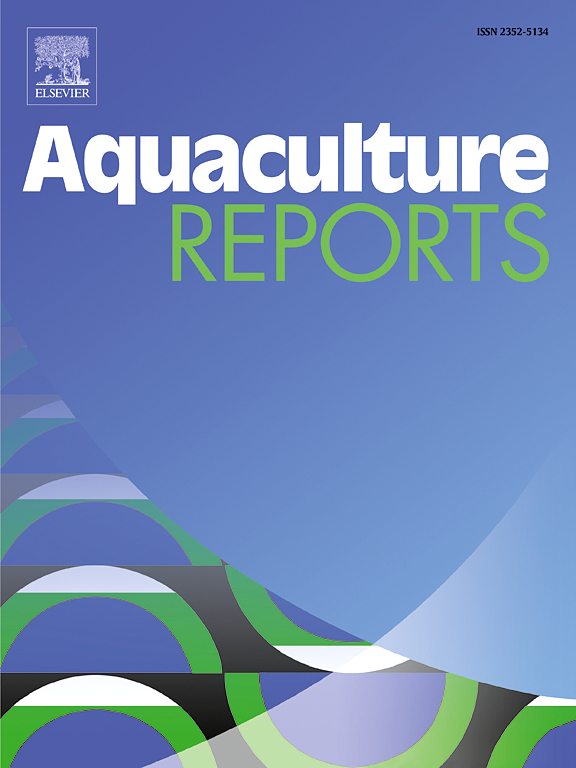牛骨粉与去酚棉籽蛋白结合可有效替代鱼粉喂养棘尾鲑:对生长、肌肉质量和肠道消化生理的综合评估
IF 3.7
2区 农林科学
Q1 FISHERIES
引用次数: 0
摘要
为了研究用牛骨粉(BBM)和去酚棉籽蛋白(DCSP)的组合替代鱼粉(FM)的可行性,我们用一种混合物(由 60 % 的牛骨粉和 40 % 的去酚棉籽蛋白组成)来替代金鲳(Tchinotus ovatus)饲料中不同水平的鱼粉。配制了五种等蛋白(47%)和离脂(12%)实验日粮,调频含量分别为 30%、24%、18%、12% 和 6%(即对照组、FM24、FM18、FM12 和 FM6)。为了弥补 FM 含量的降低,使用了 BBM 和 DCSP 作为替代品,并添加了 DL-蛋氨酸和 L-赖氨酸以维持日粮氨基酸平衡。63 天的试验结果表明,与对照组相比,FM24、FM18 和 FM12 组的生长没有显著差异,而 FM6 组的生长则明显下降。全鱼的生化成分在五个组之间没有明显差异,而 FM12 组的肌肉蛋白质含量高于对照组。FM12 组和 FM6 组的大部分肌肉纹理特性都发生了积极变化。随着替代率的增加,血清总蛋白、白蛋白、总氨基酸和胆囊收缩素的含量升高,而血清肽 YY 的含量降低。此外,FM18、FM12 和 FM6 组的肠道胰蛋白酶、NaK-ATP 酶和碱性磷酸酶活性降低,脂肪酶活性呈相反趋势。氨基酸感受器相关基因(asct2和snat2)的转录水平随着日粮中FM替代量的增加而下调,而食欲调节因子(pept1、ck和ghrl)的表达水平则上调。总之,通过结合使用 BBM 和 DCSP,可将卵形瘤鲫鱼日粮中的 FM 含量降至 12%,且未观察到对生长性能、生化成分或肌肉纹理的不利影响。本文章由计算机程序翻译,如有差异,请以英文原文为准。
Bovine bone meal combined with dephenolized cottonseed protein is an effective fishmeal substitution in Trachinotus ovatus feed: A comprehensive evaluation of growth, muscle quality, and intestinal digestion physiology
To investigate the feasibility of substituting fishmeal (FM) with a combination of bovine bone meal (BBM) and dephenolized cottonseed protein (DCSP), a mixture (consisting of 60 % BBM and 40 % DCSP) was used to replace varying FM levels in Golden pompano (Trachinotus ovatus) feed. Five isoproteic (47 %) and isolipidic (12 %) experimental diets were formulated, with FM levels set at 30 %, 24 %, 18 %, 12 %, and 6 % (namely Control, FM24, FM18, FM12, and FM6). To compensate for the reduced FM content, BBM and DCSP were used as substitutes, and DL-methionine and L-lysine were added to maintain the dietary amino acid balance. Following a 63-day trial, results showed that the growth of FM24, FM18 and FM12 groups did not exhibit significant differences compared to the Control group, while those of FM6 group considerably decreased. The biochemical composition of whole fish did not display significant differences among the five groups, while the muscle protein contents of the FM12 group were higher than the Control group. Most of the muscle texture properties were positively modified in the FM 12 and FM 6 groups. With the substitution ratio increase, the contents of serum total protein, albumin, total amino acids, and cholecystokinin were elevated, while serum peptide YY contents decreased. In addition, intestinal trypsin, NaK-ATPase, and alkaline phosphatase activities in FM18, FM12, and FM6 groups decreased, and lipase activities exhibited the opposite trend. The transcription levels of genes related to amino acid-sensing receptors (asct2 and snat2) were down-regulated with increasing dietary FM substitutions, while the expression levels of appetite regulation factors (pept1, cck, and ghrl) were up-regulated. In conclusion, the FM content in the diet of T. ovatus can be reduced to 12 % through the utilization of a combination of BBM and DCSP, with no adverse effects observed on growth performance, biochemical composition, or muscle texture.
求助全文
通过发布文献求助,成功后即可免费获取论文全文。
去求助
来源期刊

Aquaculture Reports
Agricultural and Biological Sciences-Animal Science and Zoology
CiteScore
5.90
自引率
8.10%
发文量
469
审稿时长
77 days
期刊介绍:
Aquaculture Reports will publish original research papers and reviews documenting outstanding science with a regional context and focus, answering the need for high quality information on novel species, systems and regions in emerging areas of aquaculture research and development, such as integrated multi-trophic aquaculture, urban aquaculture, ornamental, unfed aquaculture, offshore aquaculture and others. Papers having industry research as priority and encompassing product development research or current industry practice are encouraged.
 求助内容:
求助内容: 应助结果提醒方式:
应助结果提醒方式:


